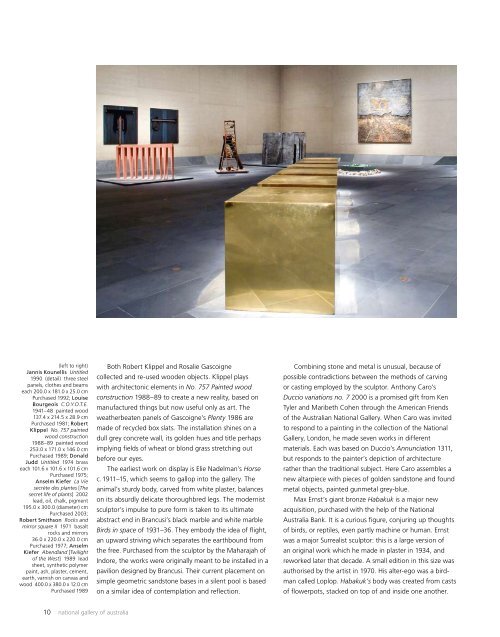Art Ew - National Gallery of Australia
Art Ew - National Gallery of Australia
Art Ew - National Gallery of Australia
Create successful ePaper yourself
Turn your PDF publications into a flip-book with our unique Google optimized e-Paper software.
(left to right)<br />
Jannis Kounellis Untitled<br />
1990 (detail) three steel<br />
panels, clothes and beams<br />
each 200.0 x 181.0 x 25.0 cm<br />
Purchased 1992; Louise<br />
Bourgeois C.O.Y.O.T.E.<br />
1941–48 painted wood<br />
137.4 x 214.5 x 28.9 cm<br />
Purchased 1981; Robert<br />
Klippel No. 757 painted<br />
wood construction<br />
1988–89 painted wood<br />
253.0 x 171.0 x 146.0 cm<br />
Purchased 1989; Donald<br />
Judd Untitled 1974 brass<br />
each 101.6 x 101.6 x 101.6 cm<br />
Purchased 1975;<br />
Anselm Kiefer La Vie<br />
secrète des plantes [The<br />
secret life <strong>of</strong> plants] 2002<br />
lead, oil, chalk, pigment<br />
195.0 x 300.0 (diameter) cm<br />
Purchased 2003;<br />
Robert Smithson Rocks and<br />
mirror square II 1971 basalt<br />
rocks and mirrors<br />
36.0 x 220.0 x 220.0 cm<br />
Purchased 1977; Anselm<br />
Kiefer Abendland [Twilight<br />
<strong>of</strong> the West] 1989 lead<br />
sheet, synthetic polymer<br />
paint, ash, plaster, cement,<br />
earth, varnish on canvas and<br />
wood 400.0 x 380.0 x 12.0 cm<br />
Purchased 1989<br />
10 national gallery <strong>of</strong> australia<br />
Both Robert Klippel and Rosalie Gascoigne<br />
collected and re-used wooden objects. Klippel plays<br />
with architectonic elements in No. 757 Painted wood<br />
construction 1988–89 to create a new reality, based on<br />
manufactured things but now useful only as art. The<br />
weatherbeaten panels <strong>of</strong> Gascoigne’s Plenty 1986 are<br />
made <strong>of</strong> recycled box slats. The installation shines on a<br />
dull grey concrete wall, its golden hues and title perhaps<br />
implying fields <strong>of</strong> wheat or blond grass stretching out<br />
before our eyes.<br />
The earliest work on display is Elie Nadelman’s Horse<br />
c. 1911–15, which seems to gallop into the gallery. The<br />
animal’s sturdy body, carved from white plaster, balances<br />
on its absurdly delicate thoroughbred legs. The modernist<br />
sculptor’s impulse to pure form is taken to its ultimate<br />
abstract end in Brancusi’s black marble and white marble<br />
Birds in space <strong>of</strong> 1931–36. They embody the idea <strong>of</strong> flight,<br />
an upward striving which separates the earthbound from<br />
the free. Purchased from the sculptor by the Maharajah <strong>of</strong><br />
Indore, the works were originally meant to be installed in a<br />
pavilion designed by Brancusi. Their current placement on<br />
simple geometric sandstone bases in a silent pool is based<br />
on a similar idea <strong>of</strong> contemplation and reflection.<br />
Combining stone and metal is unusual, because <strong>of</strong><br />
possible contradictions between the methods <strong>of</strong> carving<br />
or casting employed by the sculptor. Anthony Caro’s<br />
Duccio variations no. 7 2000 is a promised gift from Ken<br />
Tyler and Maribeth Cohen through the American Friends<br />
<strong>of</strong> the <strong>Australia</strong>n <strong>National</strong> <strong>Gallery</strong>. When Caro was invited<br />
to respond to a painting in the collection <strong>of</strong> the <strong>National</strong><br />
<strong>Gallery</strong>, London, he made seven works in different<br />
materials. Each was based on Duccio’s Annunciation 1311,<br />
but responds to the painter’s depiction <strong>of</strong> architecture<br />
rather than the traditional subject. Here Caro assembles a<br />
new altarpiece with pieces <strong>of</strong> golden sandstone and found<br />
metal objects, painted gunmetal grey-blue.<br />
Max Ernst’s giant bronze Habakuk is a major new<br />
acquisition, purchased with the help <strong>of</strong> the <strong>National</strong><br />
<strong>Australia</strong> Bank. It is a curious figure, conjuring up thoughts<br />
<strong>of</strong> birds, or reptiles, even partly machine or human. Ernst<br />
was a major Surrealist sculptor: this is a large version <strong>of</strong><br />
an original work which he made in plaster in 1934, and<br />
reworked later that decade. A small edition in this size was<br />
authorised by the artist in 1970. His alter-ego was a birdman<br />
called Loplop. Habakuk’s body was created from casts<br />
<strong>of</strong> flowerpots, stacked on top <strong>of</strong> and inside one another.

















